Adrift in Time | Why Peddocks Island Is an Island Community Like No Other
Modern life seems far removed from this Massachusetts island community.
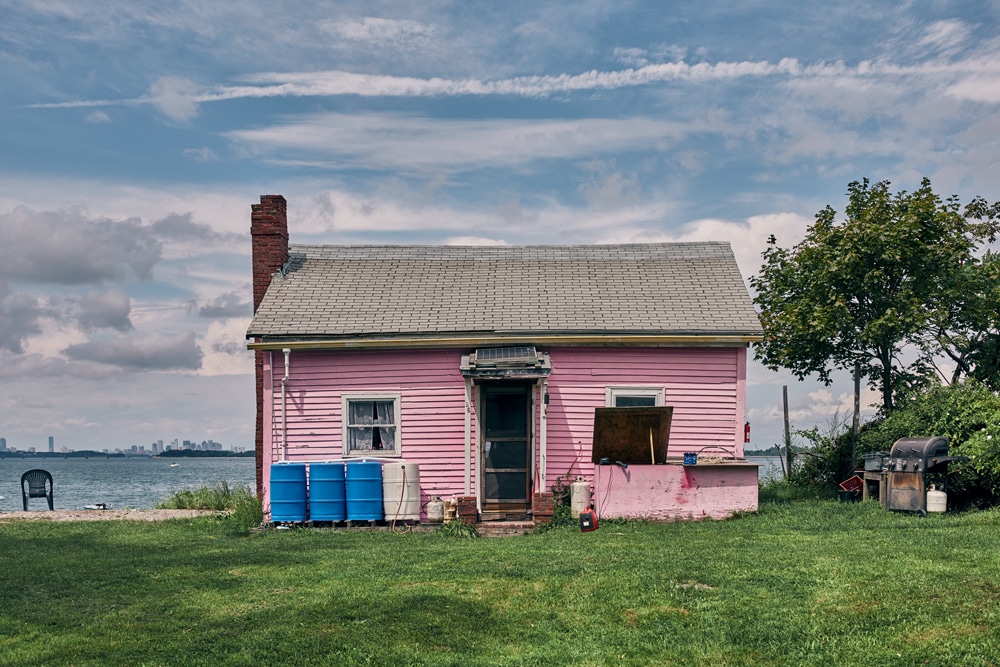
Part of a Portuguese fishing village turned summer colony, a weatherworn cottage on Peddocks Island looks out toward downtown Boston, less than eight miles away.
Photo Credit : Tony LuongBy Erick Trickey
From the sky over Boston Harbor, Peddocks Island looks like a baby bird, its body and tufted tail pointed southwest toward Quincy while its rounded head reaches, as if eager for food, toward the town of Hull. After arriving at the ferry dock on East Head, most visitors to Peddocks walk straight ahead to the brick barracks of Fort Andrews, where U.S. soldiers trained for three wars, watched over the harbor, and guarded more than 1,000 Italian detainees in the 1940s. Only a few visitors turn left, pass the white clapboard chapel, and hike to the most vibrant spot on any Boston Harbor island, a century-old Portuguese fishing village.
The footpath down Peddocks’s neck builds anticipation. The narrow dirt track threads through a stand of trees, which opens to reveal a white cottage set on a hill. An island caretaker built the home decades ago, and her family still lives in it. Here, quiet descends, except for waves lapping on the beach and the occasional airplane roaring toward Logan Airport. The path continues on, past scraggly brush and marsh and through the woods. Then more cottages emerge from the trees: rows of them, each one story tall, made of wood and standing amid well-mowed grass. Each has its own color scheme—white with red trim, yellow, sky blue, pink.
Relaxing in a lawn chair near his cottage, Jim Saudade gazes at Boston’s skyline on the western horizon. He’s wearing retired-guy summer casual: red polo shirt, white shorts, black sandals. “Peddocks Pirate,” reads his white baseball cap.
“I’ve loved it since the first day I came,” Saudade says of Peddocks. He grew up on Hough’s Neck in Quincy, and he’s been coming here since the 1950s, when his father bought the brick-red cottage he owns now. “I’ve always wanted to spend the summer here, but I wasn’t able to until [retiring] 10 years ago.” Now he spends eight months in Florida and four months on the island.
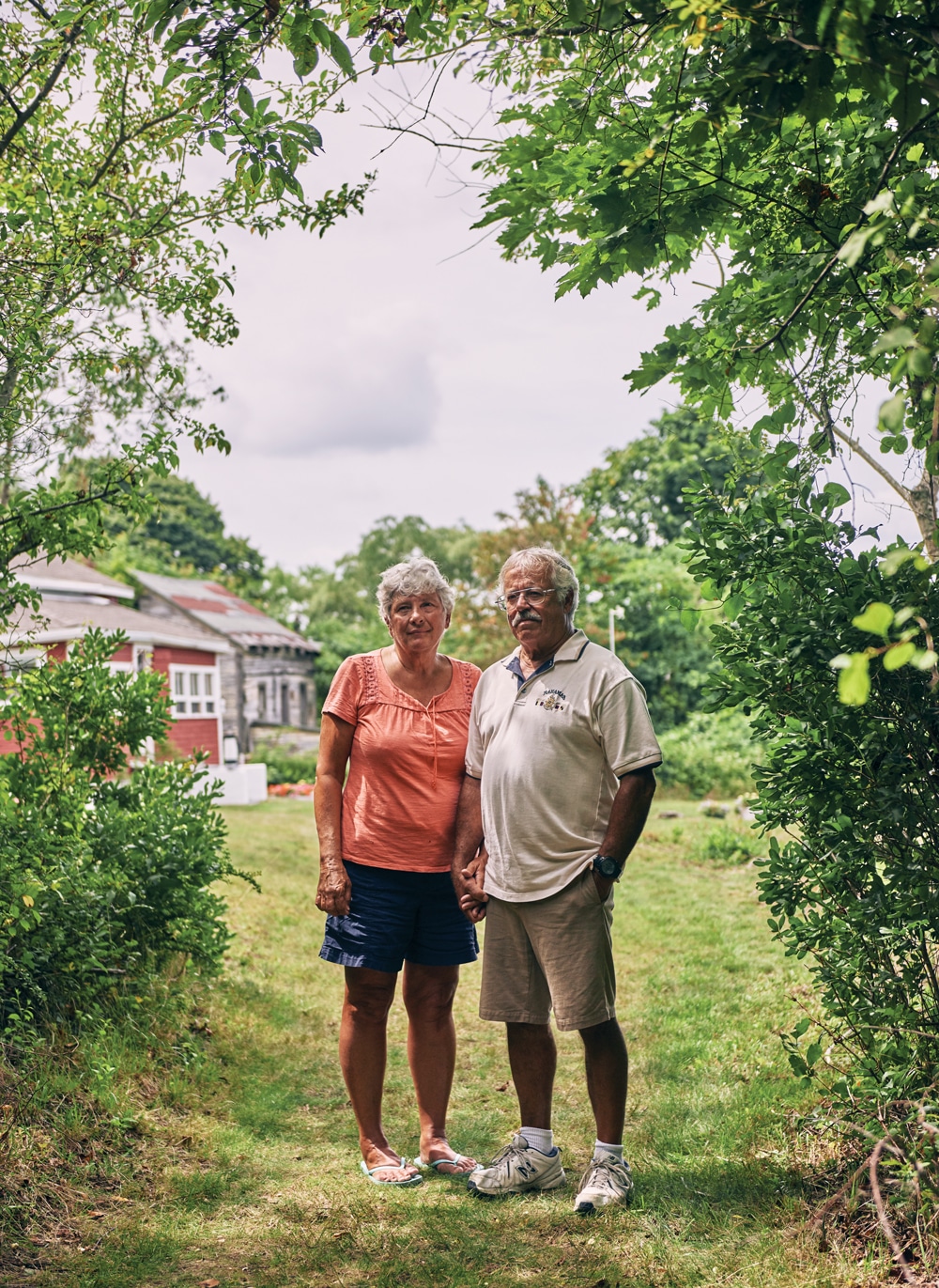
Photo Credit : Tony Luong
Saudade and his summer neighbors are the only people who live on a Boston Harbor island. Their community of about 24 cottages traces its roots back to 1887—the year that Portuguese immigrant fishermen migrated to Peddocks after the city of Boston forced them off nearby Long Island. The village survives as a remote summer getaway, a frontier outpost within sight of the Boston skyline. Families have passed the cottages down for decades, and many still return each summer with supplies of water and food.
Peddocks cottagers live off the grid, with outhouses instead of bathrooms, showers fed by rain barrels, and solar panels and batteries for electricity. While they aren’t full-time back-to-the-landers, they’ve come to see their island community as a test of character and commitment, built on hard work, careful planning, and mutual aid.
Saudade may have a kerosene lamp on his dining room table, but he’s jury-rigged modern conveniences for his home. He’s like an island-retiree version of MacGyver, the TV tinkerer who escaped weekly crises with a Swiss Army knife and duct tape. Twelve barrels catch water from the roof’s gutters. Solar-powered pumps send the water to an indoor toilet, shower, and sink. Two rooftop solar panels and a battery feed electrical outlets for lights and phone chargers. Saudade plans to keep coming back to Peddocks “as long as I’m alive, if I can,” he says. “It is a challenge as you get older. So I’m trying to meet those challenges with some ingenuity.”
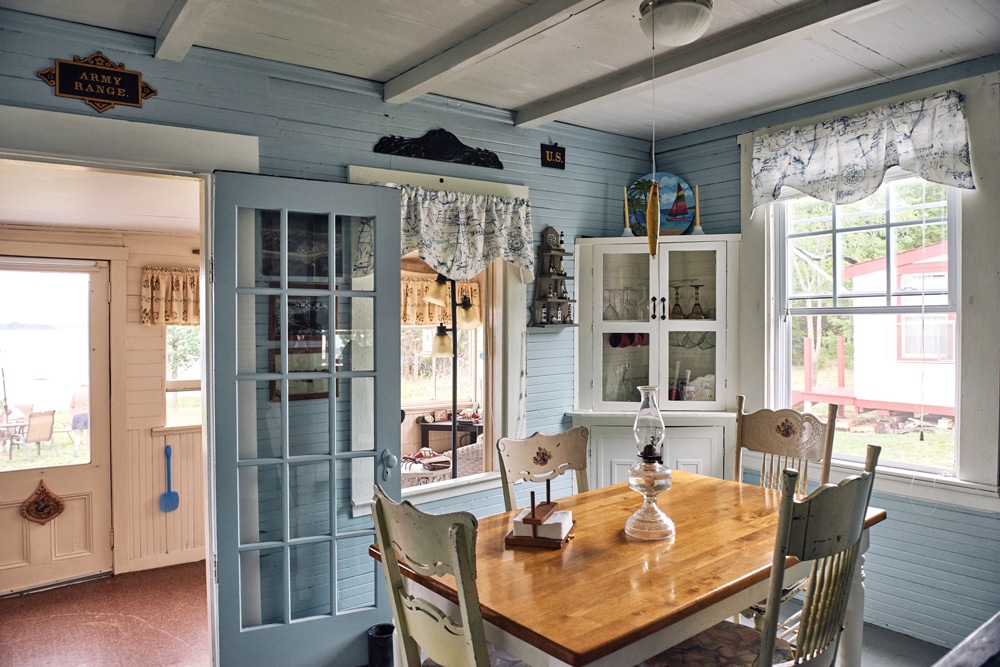
Photo Credit : Tony Luong
The Peddocks Island community has an expiration date no one knows. The houses were built before Massachusetts seized the island by eminent domain in 1970 for a park. But the cottagers never owned the land under their summer homes; they only leased it. In 1993, after the cottagers protested an attempted eviction, a state commission settled on a compromise: life tenancy. The cottagers pay $400 for annual permits to return to the island from May through October, but they can’t sell the permits or pass them on to family. So Saudade’s generation of cottagers will be among the last on Peddocks Island. When they pass away, so will their community, and its way of life.
– – –
For the cottagers, Peddocks Island has long been a refuge where time, conflict, and even everyday identity wash away. “If I had a lot of problems here on the mainland, when I got on that island, that was the other guy,” says Jack Downey, a retired salesman from Norwell, Massachusetts. “It was like living two separate lives. I was John Downey here on the mainland, but I was Captain Jack out there.”
Downey was 32 and his wife, Mary, was 25 in the summer of 1968, when they bought a cottage on Peddocks Island’s Crab Alley, a cozy row of cottages that was named after the seafood the village’s founders caught and sold. In August 2017, at 81 and 74, just before they relinquished their cottage to the state due to health problems, the couple sailed to Peddocks Island to visit their summer home one last time.
The Downeys’ cottage had oil lamps, an outhouse, and a well in back for water and for keeping food cold. They’d been away for two years, recovering from surgeries—his neck, her back—but everything was just as they’d left it.
“It was like the clock had just stopped,” Mary says. “You open the door, and the clock starts up again. Time stands still on the island.”
But stopping time takes a considerable amount of work. “Lug and Tug Island,” some cottagers call Peddocks, because of the physical effort that’s required to get things like food, drinking water, laundry, and propane to their summer homes. And the cottages themselves, decades old, are prone to decay (the state demolished several after their owners gave them up or passed away), so with the closest hardware store miles away by boat, the cottagers have to get inventive.
Jack Enos, a Brookline civil engineer, has come to his cottage every year since 1957; his memories of the summer of 1969, when he was 12, include watching the moon landing on a battery-powered black-and-white TV on the porch. His family would pick up driftwood and take hinges off shipwrecks on the beach. “You could look under this house, and it’s like a lumber yard,” he says. “There’s jars full of hinges my father probably put there when he was a kid.” Other favorite Peddocks memories include “figuring stuff out,” he says. “I think as an island person, you have to have this self-reliance.”
Ken and Annie Clark have a rooftop solar panel to power their laptops, tablet, printer, and scanner. The two financial advisors who live near Bradenton, Florida, spend July and August working from the mustard-yellow cottage that Ken’s mother bought in 1967. Their desks stand next to panoramic kitchen windows that look out on Hull and sailboats heading out of the Hingham Yacht Club.
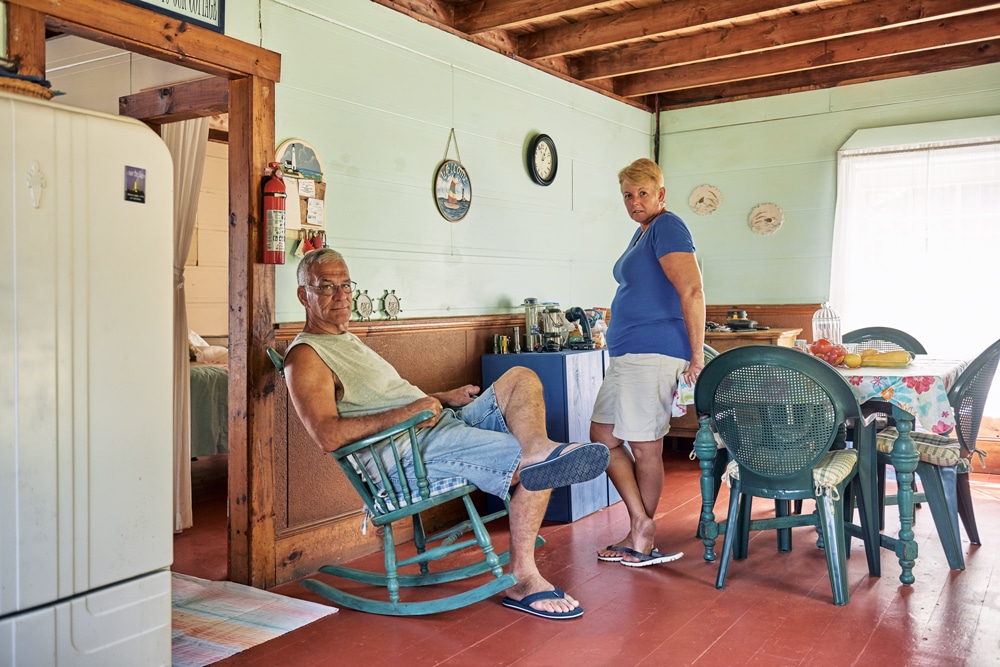
Photo Credit : Tony Luong
Island living gives the Clarks a break from their daily routine of ringing phones and computer screens. Their propane-powered refrigerator dates to 1932. A gas light illuminates the kitchen. For many years they showered in an outdoor stall with well water heated in the sun. “It goes when I go,” Ken says of the cottage. “Till death do us part.”
Every week or so in summer, Jim Saudade visits the mainland to do laundry and buy propane and groceries. “You have to live by the tides and weather,” he says. Low tide means a longer haul from shore. If winds are gusting more than 30 miles an hour, he says, most cottagers won’t leave the island.
But it’s worth it, Saudade says, for the chance to spend a relaxed summer grilling and baking pizzas, reading, and listening to the island’s coyotes (“I’ve heard them singing, and there’s at least four or five voices sometimes,” he says). In the evenings, he visits his neighbors; like him, many grew up in Boston’s South Shore suburbs. “I’ve known most of these people since I was a little kid,” he says. Cottagers gather at a pink house at the end of Crab Alley to watch the sun set. “Some people call it the island family,” he says.
That family is also a mutual-aid society. “The island way is, we all have to help each other and watch out for each other,” Saudade says. Peddocks has no emergency services other than the police and fire boats that patrol Boston Harbor. So Saudade refreshes his CPR and first aid training every year, in case of an island crisis.
“The scariest thing out here,” Saudade says, “is fire.” About 50 years ago, a blaze broke out in a cottage next door to his, and he tells the story as if it were yesterday: how two dozen neighbors formed a bucket brigade to douse the flames with rain-barrel water. “People took the water one bucket at a time, and hand to hand, into the house,” he says. “We got it out.”
– – –
Happening upon the Peddocks Island cottages can be a surreal surprise for a park visitor. Suddenly you’re walking right past people’s front doors, with their belongings visible in the windows. This community is a peculiar no-man’s land between public and private, between a preserved past and a lingering present.
“People walk through yards,” says Bill Hale, whose wife’s family has summered here since 1918. “But the [cottagers have] gotten around to accept it. Those that were very belligerent about it in the beginning and nasty to visitors have mellowed out with old age.”
Most cottagers, in fact, say they enjoy interacting with park visitors. “When they hear you’re a cottage owner here,” says Annie Clark, “and you share some of the history, they’re very excited.”
As a state-owned park interpreted by the National Park Service, Peddocks Island is filled with both natural beauty and human history. The island wouldn’t be as interesting without Fort Andrews’s barracks, which reflect a soldier’s-eye view of the world wars, or without the historic cottages—and the cottage families themselves.

Photo Credit : Tony Luong
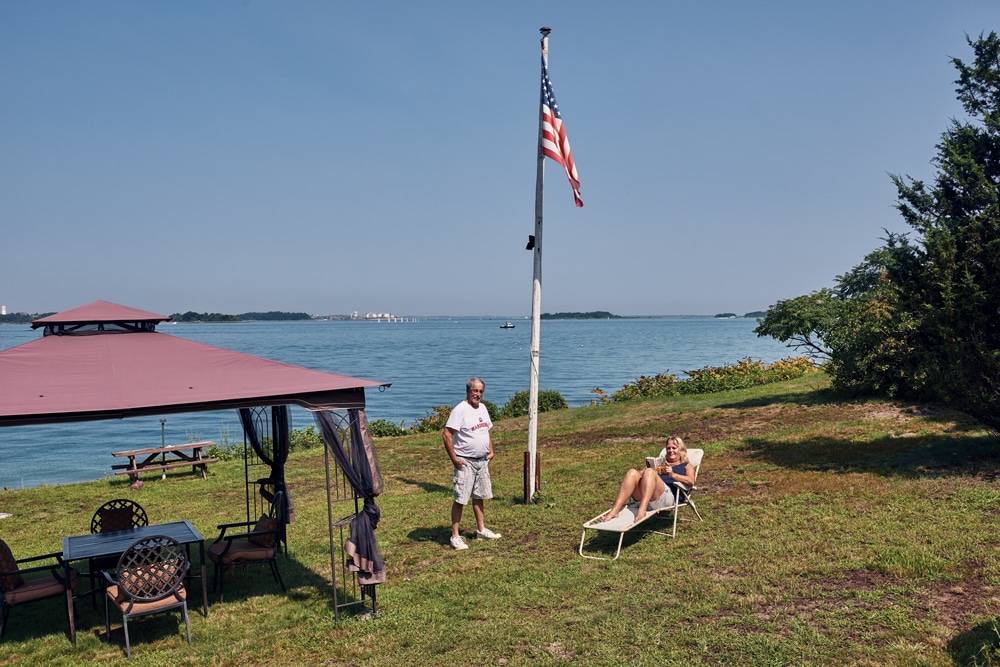
Photo Credit : Tony Luong
“One of the reasons that Peddocks is interesting to me is [the cottagers are] going, but they’re not gone,” says Cathy Stanton, a Tufts University anthropologist and author of a recent ethnographic study of the Peddocks Island cottagers. Her study, which was commissioned by the National Park Service, concludes that nearly all the residents have “ties of kinship, occupation, or friendship” to either the Azorean fishing families who came to the island after 1887 or the next generation of Portuguese-Americans, who built the cottages. “This really is a traditional community,” she says.
Stanton, who grew up visiting her family’s cottage in Ontario, Canada, says the Peddocks cottagers share a feeling she remembers: how time spent in seasonal communities often seems “more intense than real life.” The challenges of remote island living magnify that feeling. Stanton says cottagers often share stories about water, wells, and fire. “They show you how very close to the edge this environment is,” she says. A Peddocks ghost story tells of a cottager drowning in a cursed well. There’s no evidence it really happened, says Stanton, but the story has a moral: “If you wanted to be on the island, to survive you had to pay attention to water.”
The cottagers are among the few people who are still living in Massachusetts parks. On the Cape Cod National Seashore, people continue to summer in some of the 19 historic dune shacks, which were added to the National Register of Historic Places in 2012. In Myles Standish State Forest in Plymouth, 143 private cabins are gathered around five ponds, thanks to a state rental program that began in 1919. Ashmere Lake State Park in Hinsdale has 15 private cottages. The state Department of Conservation and Recreation (DCR) asserts its rights as a landlord at Peddocks, Myles Standish, and Ashmere Lake by issuing annual permits to cottagers under a “seasonal cottage campsite program.”
Photo Credit : Tony Luong
What will happen to the Peddocks community as more residents pass away or surrender their cottages isn’t yet decided. For decades, the DCR has tried to phase out the cottagers’ private use of parkland. Neglect and demolition have become its unspoken policies: It tore down several vacant, decaying cottages in 2001 and razed a dozen more in 2018. Before their demise, two sagging, empty cottages on Crab Alley were decorated with blue, red, purple, and green lobster-trap buoys—neighbors’ efforts to keep entropy at bay.
In 2001, the Massachusetts Historical Commission declared the Peddocks Island cottages eligible for the National Register of Historic Places, saying they were worthy of preservation as “highly significant” parts of the Boston Harbor Islands’ history. The commission has pressured the DCR to find new uses for the cottages—and to allow owners to once again hand down their cottages to heirs. But according to spokesman Troy Wall, the DCR has no plans to change the life tenancy policy. “As cottages become state property,” he says, “they will be assessed to determine whether the cottages can be salvaged for possible use.”
Draft options for a Peddocks Island redevelopment plan released in 2019 by the DCR, the National Park Service, and the nonprofit Boston Harbor Now include razing the cottages to replace them with glamping tents or making them into a “cottage community cultural center” that would share stories of the cottagers and their lives on Peddocks.
So the government may someday commemorate the cottage community—after forcing its demise. “Ten years from now,” jokes Jack Downey, “they’ll be hiring us to go out there and role-play as the people who lived in the village.”


